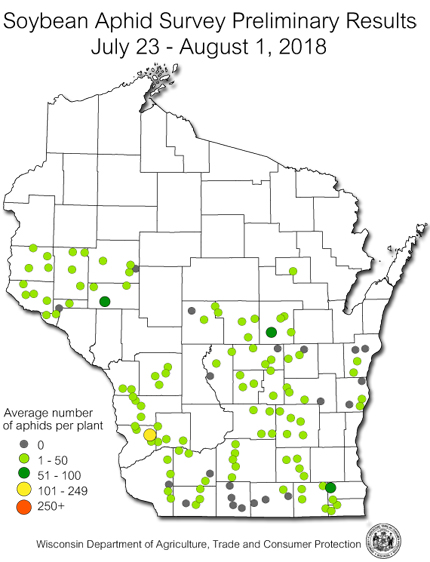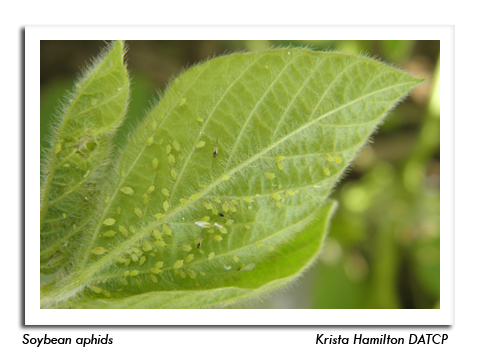
 |
|
|
Soybeans
Volume 63 Number 14 Date 08/02/2018 SOYBEAN APHID - Surveys conducted from July 23-August 1 found no economic populations at 128 sampled sites. Densities were low (<20 aphids per plant) in the majority of fields, with only three fields in Crawford, Eau Claire and Waupaca counties having averages above 100 aphids per plant. Although surveys indicate populations are low or moderate, aphid pressure usually intensifies this time of year, and some fields may still require treatment by mid-August. Soybean producers are reminded that control is not advised until the economic threshold of 250 aphids per plant on 80% of the plants throughout the field has been exceeded. In addition, plants at R5.5 or later are unlikely to suffer significant yield loss regardless of aphid population, unless under other stress such as drought. Waiting until this threshold to apply insecticides is critical for ensuring continued effectiveness of current insecticides available for aphid management. Once again, field-wide average counts have not surpassed this level in any soybean field surveyed by DATCP this season. All soybeans should be examined next week to evaluate aphid densities. PYRETHROID RESISTANT APHIDS - Pyrethroid insecticide applications that fail to control aphid infestations may be an indicator of a resistant population. Producers or advisors who suspect pyrethroid performance issues are asked to contact the DATCP Pest Survey Program (krista.hamilton@wi.gov) to have aphids sampled and tested. JAPANESE BEETLE - Defoliation is prevalent again this year. Japanese beetles are causing variable damage to soybean field margins, especially in the southeast and west-central areas. The highest counts (40-140 beetles per 100 sweeps) have been documented in Grant, Jefferson, Kenosha, Monroe, Rock and Walworth counties. Average defoliation rates in fields surveyed since late July have generally been below the 20% threshold for soybeans in the reproductive stages, but a few fields have developed economic defoliation levels in the range of 25-30%. -- Krista Hamilton, DATCP Entomologist SOYBEAN ROOT ROT - Fifty-four soybean fields were surveyed for seedling root rot diseases from June 11- July 6. Laboratory testing confirmed Phytophthora sojae in 46% of the fields. The 2018 prevalence of P. sojae was an increase from 24% of fields in 2017 and 32% in 2016. Development of Phytophthora is favored by wet spring weather with warm, intermittently damp soils. DATCP surveys in the last decade have found P. sojae prevalence ranging from 13% in 2011 to 49% in 2014. A second Phytophthora species, P. sansomeana, was also detected in three fields. Phytophthora sansomeana was first identified in Wisconsin soybeans in 2012 and has now been documented in 12 counties: Calumet, Dane, Dodge, Dunn, Eau Claire, Green, Jefferson, Outagamie, Marathon, Rock, Sheboygan, and Winnebago. -- Sam Christianson, DATCP Plant Industry Lab 


|
|
|